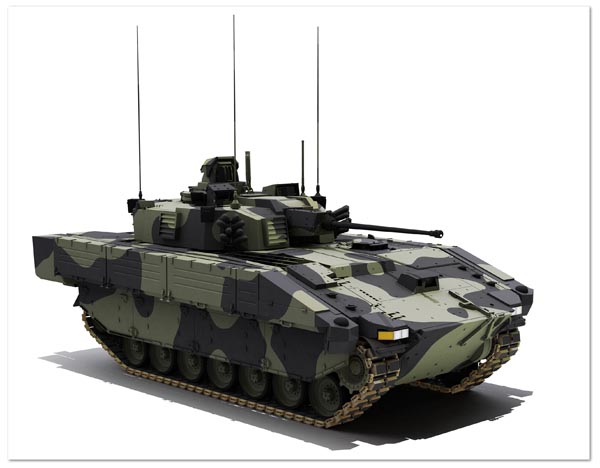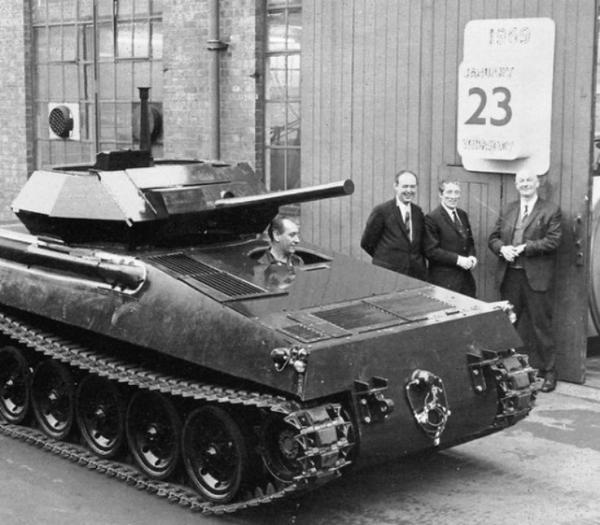Inevitably, somebody had to call them "tanks" and it was left to the girlie-boys in the Telegraphto do the honours, with the typically naff headline: "Army places £3.5bn order for new tanks with General Dynamics".
This, in fact, is the first instalment of the much-delayed FRES (Future Rapid Effects System), which I first wrote about in July 2004, when the system had strong "European" defence overtones (and still does).
The technical development has been charted in detail by the admirable Think Defence blog, which notes that this newly ordered Scout vehicle replaces the grossly obsolescent CVR(T) series, which had its roll-out in January 1969 (see below), and has seen action in virtually every theatre since, to which the British Army has been committed.
Initially, the front-runner for FRES had been the utility vehicle, the political implications of which I was also exploring in July 2004. Then, after a spirited campaign against the vehicle, part of which is charted in Ministry of Defeat, we saw it effectively abandoned in October 2009.
By then there were already indications that the thinking had shifted to the CVR(T) replacement, with bids being invited from BAE Systems Global Combat Systems and General Dynamics. In the event, although BAE Systems proposed fielding the tried and tested Swedish-built CV-903 Mk III as a platform, General Dynamics have won the contract with what appears to be a new-build platform.
David Cameron, attending the two-day NATO summit in Newport, S. Wales, says the deal will aid UK security and "underpin" many jobs, reminding people that it would be the Army's largest single order for armoured vehicles for more than 30 years.
"These new vehicles are testament to the world-class engineering skills in south Wales and across the UK, helping to create the Army's first fully digitalised armoured vehicles," he says.
Sadly, though, this rhetoric doesn't get close to the reality. What the order demonstrates is that this is an Army that is remembering past days of glory, and what it needs on the battlefields or yore, dominated free manoeuvre and the exhilaration of the mobile battle.
What it also demonstrates is that the Army still doesn't have the first idea of what sort of battles it is going to have to fight in the future and, as it so often does, is selecting kit for the battles it would like to fight, rather than the ones to which it will be committed.
Thus we end up with a clanking, heavily armoured scout vehicle. At 42 tons, it is more than twice as heavy as the original concept, which demanded air mobility based on the C-130 platform. But nothing short of a giant C-17 will lift one of these, and then only one at a time.
On the other hand, despite the weight and armour, its protection against IEDs will be poor – as we saw, even with the uparmoured Warriors, which were extremely vulnerable in certain counter-insurgency operations.
That leaves us with a vehicle at £6 million a pop, almost six times the original buying price of a well-protected Mastiff, which will afford only a fraction of the capability in the type of operations for which the Army is most often called upon to perform.
The greater lacuna, though, is that this is a military machine devoted to collecting real-time information on the conduct of a conventional engagement. It is not an "intelligence" machine, as such, so much as reconnaissance vehicle, designed to pave the way for fast-moving armoured formations - which we haven't actually got – to fight a type of battle that we are most unlikely to encounter.
In my experience, what the Army most lacks is a strategic intelligence capability, which enable it to understand the complex situations into which it is deployed, and then an ongoing going capability to analyse the information it does get, in order to fit it into a coherent tactical framework.
Here, it is very much the experience of those on the ground that there is no shortage of information – per se. Rather, the information very often does not get to the people who need it, analytical capabilities are poor, and the distribution of the finished "intelligence" product is overly restrictive.
So what we have to day is Mr Cameron agreeing to pay £3.5bn of our money, to buy the Army some information-gathering machines, to inject more data into a creaking system that is unable to handle what it already gets, most of which will be unusable anyway, because it will be the wrong sort of information for the wrong sort of war.
However, there is nothing the Generals like than their new toys so, for a while, the Army will be kept quite while it absorbs and learns how to play with its new kit.
And, as long as we never ask the Army actually to use it for real, and deliver any results, things will work out magnificently. But if we ever have to fight a real war, we'll have to hope that the US is still on side. It's not that they don't make the same mistakes – they do. But they have enough cash to buy the sort of gear and systems needed as well.

